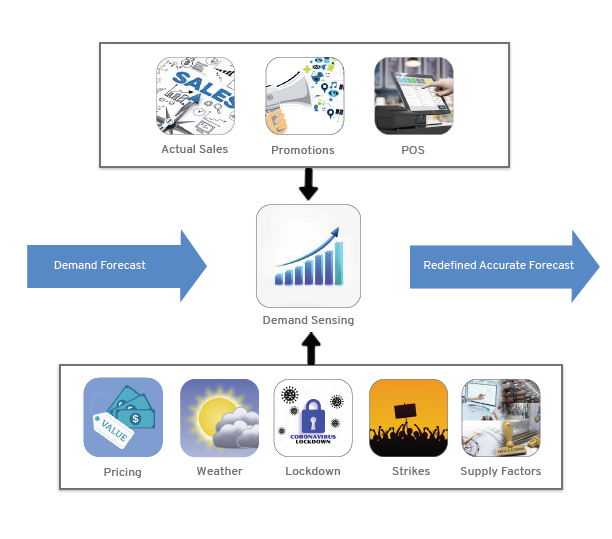The goal of supply chain planning is to improve forecast accuracy and optimize inventory costs throughout the supply distribution network. Without proper planning, there is a chance of overstocking leading to high inventory costs or understocking leading to stock out situations causing revenue loss.
When a company produces more than the demand, the stock sits unsold in the inventory. Therefore, this increases the inventory holding cost, later leading to waste and obsolescence costs. When a company produces less than the customer demand, there is a revenue loss and in today’s competitive business environment this might also lead to future revenue losses.
Getting demand forecasting accurate is the key to success in today’s supply chain planning. However, there are various reasons why this demand-supply mismatch occurs and forecasting accuracies drop. Customers’ needs and requirements constantly change, maybe due to:
- Introduction of new technology
- Fast fashion
- Promotional discounts
- Point-of-sales
- Weather
- Strikes
- Lockdowns

For example, when the first wave of the pandemic hit, people minimized their purchases like clothes, cosmetics, etc., thinking they won’t be using these items quite often. However, there was an exponential rise in the purchase of luxury goods as well as insurance (health and life). People also bought immunity boosters, comfort foods, groceries, digital services, and appliances. Additionally, there was a shift in how people perceived and bought commodities. This leads to uncertainties in aggregate demand. As companies try to fulfill the demand, there is a mismatch between supply and demand.
Traditional classical forecasting methods find it difficult to predict demand accurately in today’s dynamic business environment. However, Statistical forecast models rely solely on historical sales data and they fail to evaluate the impact of various other variables that impact sales demand. Product manufacturing and distribution must be aligned with supply-demand volume variabilities so that the companies can have accurate demand forecasts, close to the actual sales, preparing them to stock at the right place at the right time in the right quantities.
Using modern AI / ML technologies Demand Sensing has now made it possible to analyze the impact of these variables on sales demand and enable them to predict demand more accurately. Therefore, it is fast becoming an indispensable tool in supply chain planning for accurate demand forecasting. Moreover, it builds upon the classical traditional forecasting methods to develop baseline forecasts and then refines these forecasts for higher accuracy by taking into account other variables that impact the sales demand on a near real-time basis. Demand Sensing leads to better demand forecasting accuracy helping organizations to improve customer demand fulfillment, enhance revenues and optimize inventory throughout their distribution network and reduce costs.
Other than optimizing the inventory to meet demands, supply chains can also migrate to a just-in-time inventory management model to boost their responsiveness to consumer’s demands and lower their costs significantly.
Data Required for Demand Sensing
AL/ML-based Demand Sensing tools can make use of a variety of data available to predict demand more accurately. Such data includes (but not limited to):
- Current Forecast
- Actual Sales data
- Weather
- Demand disruption events like strikes, lockdown, curfew etc.
- Point of Sales
- Supply Factors
- Extreme weather events like floods, cyclones, storms etc.
- Promotions
- Price
The variable may change for different businesses & organizations and any given variable can be modelled in Demand Sensing to analyze the impact on sales demand for greater accuracy.
The list above includes current data, historical data, internal data, and external data. Hence, this is exactly why AI/ML-based demand sensing is more accurate than traditional demand sensing. As large volumes of data are analyzed and processed quickly, predictions are specific making it easy for supply chains to make informed business decisions. An important factor to conduct demand sensing accurately is the availability of certain capabilities by supply chains. Let’s learn more about these capabilities.
Capabilities Required by Supply Chains for Demand Sensing
- To template demand at an atomic level
- To model demand variability
- To calculate the impact of external variables
- To process high volumes of data
- To support a seamless environment
- To drive process automation
Benefits of Demand Sensing
The major benefits of Demand Sensing for an organization are:
- Greater Demand Forecasting accuracy
- Reduced inventory and higher inventory turnover ratios.
- Higher customer demand fulfillment leading to increased sales revenues
- Enables citizen demand planners and supply planners.
- Auto-modelling and Hyper parameter
Who Benefits the Most from Demand Sensing?
- Retail/ CPG/ E-commerce
- Distribution
- Manufacturing/Supply chain/ Industrial automotive
- Chemical/ Pharmaceutical
- Food Processing
- Transport/ Logistics
- Natural Resources
Demand Sensing – Need of the Hour
As already discussed, demand sensing is required mandatorily by supply chains to manage and grow their business. In this dynamic market where most supply chains are opting for digital transformation and an automated process system, traditional methods to sense demand do not work efficiently. To gain a competitive edge and to keep the business running in the current unpredictable times, AI/ML-based demand sensing is the need of the hour.
How aptplan Can Help You
Aptus Data Labs’s AI/ML-based tool “aptplan” helps businesses access accurate demand sensing and forecasting data to plan their supply accurately. aptplan uses internal and external data with traditional techniques and advanced technology to train AI/ML models are used to predict accurate sales demand sensing on a real-time basis. It uses NLP technologies to collect a wide variety of unstructured data to convert into a structured format for use. Aptplan delivers highly accurate demand plans for better business decision-making and lower inventory costs. To know more or to request a demo, click on https://www.aptplan.ai/











